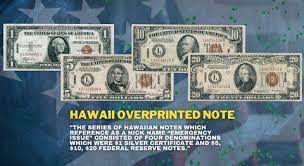World War II Emergency Issues
Early in the 2nd World War, the United States produced two different kinds of emergency currency paper money. One issue was for Hawaii and the South Pacific; the other was for Africa and Southern Europe. Today collectors refer to these notes as “Hawaii” and “North Africa”. Because the government was concerned that large amounts of U.S. money would possibly fall into enemy hands and be used against our country, these two kinds of currency were issued for U.S. troops to use in those specific areas of the world.

The 1935A series “North Africa” notes were issued to troops headed for Africa. Instead of the usual blue seal, these notes had a yellow seal. If they fell into enemy hands they could be demonetized and made worthless. These notes were issued in denominations of $1, $5, and $10. All were Silver Certificates, series 1934A.

For the “Hawaii” notes, an overprint of H-A-W-A-I-I was placed twice on the face of each note and once on the back. The Treasury seal was brown instead of the normal blue. These notes were in denominations of $1, $5, $10, and $20. The $1 notes were 1935A Silver Certificates; the other denominations were 1934A Federal Reserve Notes.
In Hawaii, the government required that all U.S. currency be replaced with notes bearing the HAWAII overstamp. This left a major problem: what to do with all the currency exchanged for the overprint version. Rather than ship all that money back to the mainland, it was decided to burn it. At first it was burned in a local crematorium, but that was taking too long. So the government used the bigger furnaces of the Aiea sugar mill to finish the job.
Clubs and Associations
- American Numismatic Association
- American Numismatic Society
- British Numismatic Society
- Central Ohio Numismatic Association
- Central States Numismatic Society
- Florida United Numismatists
- Numismatic Society of India
- the Cincinnati Numismatic Association
- The Royal Canadian Numismatic Association
- The Royal Numismatic Society
Coin Links
- Boy Scouts Merit Badge
- Buffalo Nickels
- Bureau of Engraving and Printing
- Calculate your coin's gold, silver, or metallic worth
- Coins & Currency in Colonial America
- David Lawrence Rare Coins Reference Library
- Dayton Metro Library – Coin Books
- Fixing PVC damage
- Indian Head Cents
- Legandary Coins and Currency from the Smithsonian
- Medalblog
- Mints of the World
- Monnaie de Paris
- NapoleonicMedals.org
- raregoldcoins.com
- Royal Canadian Mint
- Smithsonian Institution Collection
- Starting a coin collection
- The Kittredge Collection
- The Perth Mint
- The Pobjoy Mint
- The Princeton University Numismatic Collection
- The Royal Mint
- United States Mint
- University of Virginia Coin Collection
- Where is my coin from?
Coin News
Miami Valley Coin Dealers
Speciality Clubs
- American Tax Token Society
- Barber Coin Collectors' Society
- Dayton Diggers Metal Detecting Club
- Early American Coppers
- Encased Collectors International
- Fly-In Club
- Liberty Seated Collector's Club
- Medal Collectors of America
- National Token Collectors Association
- Numismatic Bibliomania Society
- The Bust Half Nut Club
- The Civil War Token Society
- The Colonial Coin Collectors Club
- The Elongated Collectors
- The John Reich Collectors Society
- The Society of Paper Money Collectors
- The Token and Medals Society
- Unrecognised States Numismatic Society
- Worldwide Bi-Metallic Collectors Club